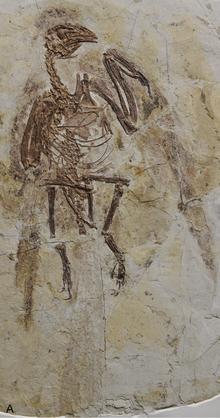Pengornithidae
| Pengornithids Temporal range: Early Cretaceous, 130.7–120 Ma |
|
|---|---|
 |
|
| Fossil specimen of Parapengornis eurycaudatus | |
| Scientific classification | |
| Kingdom: | Animalia |
| Phylum: | Chordata |
| Clade: | †Enantiornithes |
| Clade: | †Euenantiornithes |
| Family: |
†Pengornithidae Wang et al., 2014 |
| Type species | |
|
†Pengornis houi Zhou, Clarke, & Zhang, 2008 |
|
| Genera | |
Pengornithidae is a group of early enantiornithines from the early Cretaceous Period of China. Specimens of these animals have been found both in the Huajiying Formation and Jiufotang Formation of Liaoning and Hebei provinces, dating from the Hauterivian age (130.7 million years ago) to the Aptian age (120 million years ago).
Pengornithids were primitive enantiornithes. They had many small teeth in their jaws, and stout legs. Their internal anatomy was characterized by a hooked outgrowth of the shoulder blade and a pygostyle (the tail bone to which long feathers attach) which was short and rounded, instead of long and blade-shaped as in other enantiornithes. While most enantiornithes had four long backward projections growing from their breastbones, pengornithids only had two.
The unique, rounded pygostyle and long, stiff tail feathers of pengornithids would have made their tail overall similar to that of woodpeckers. The feet of pengornithids were also particularly adapted for grasping branches. These features indicate that while pengornithids may not have been as adept at climbing and many modern birds, they were better climbers than many other enantiornithes.
The cladogram below was found in the phylogenetic analysis of Hu et al. 2014.
...
Wikipedia
